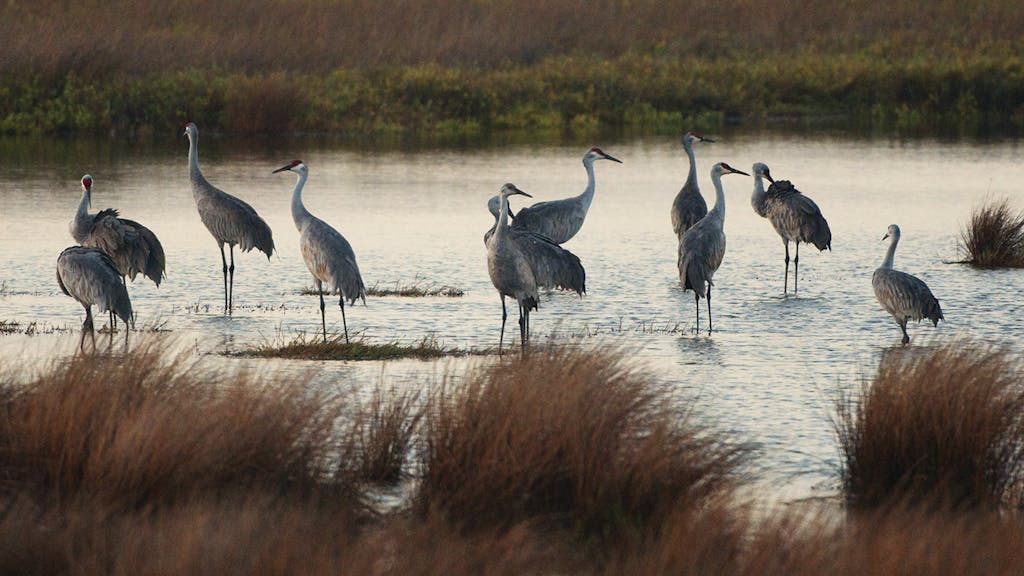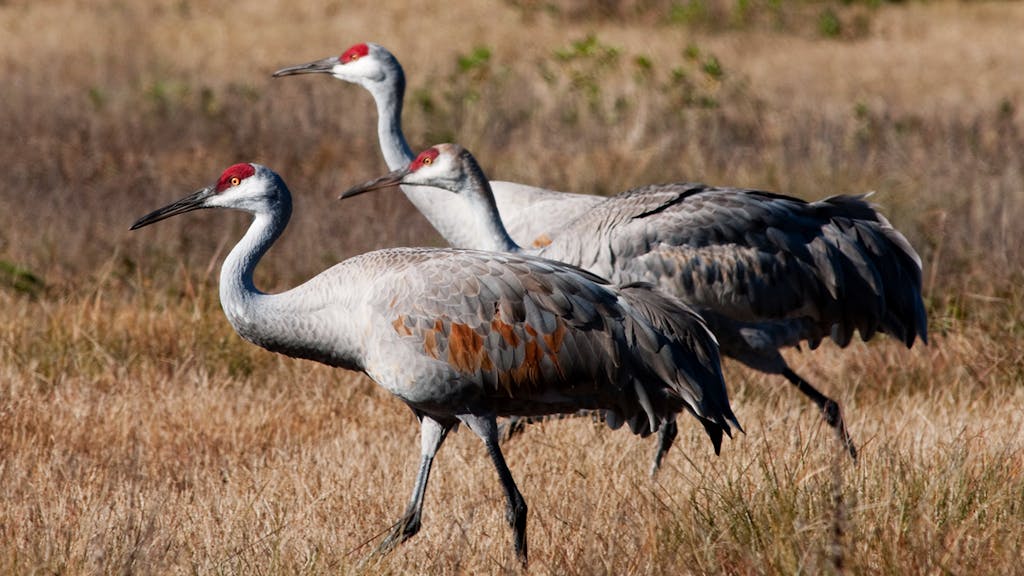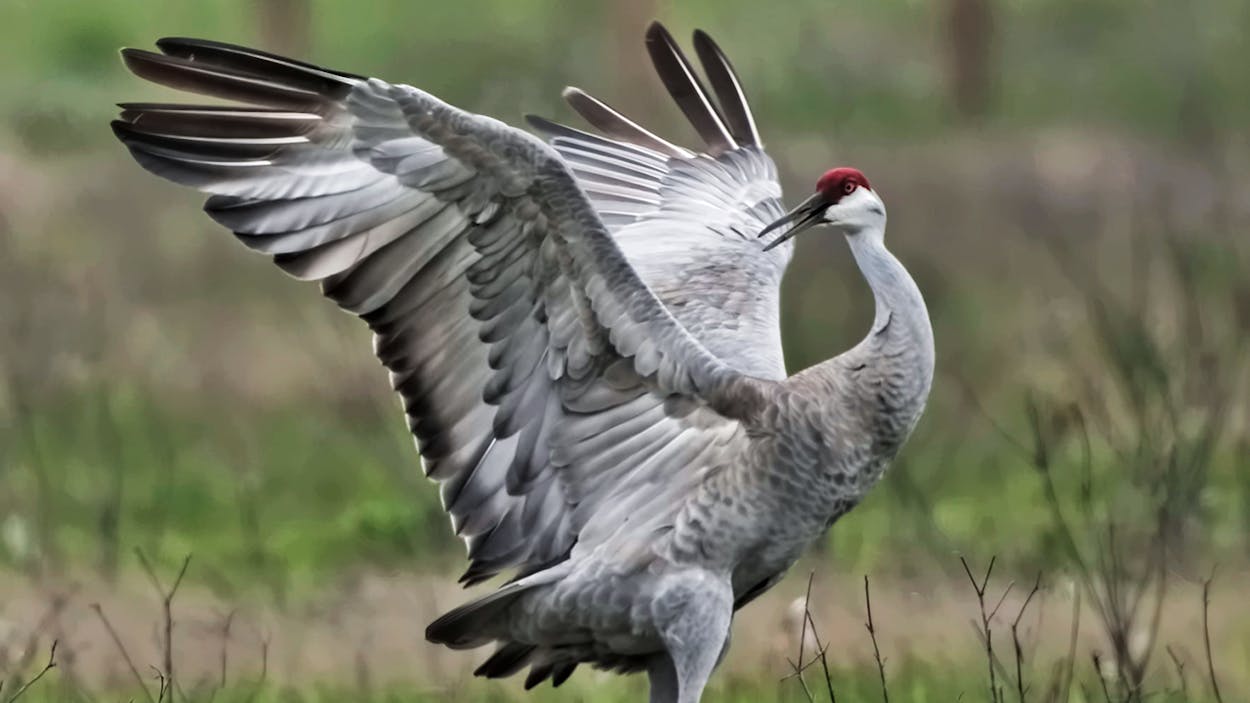To understand the crane, the family of birds with exaggerated necks and legs, one must first understand the difference between the two species found in North America that call the Texas coast home during the winter: The sandhill crane and the whooping crane.
Let’s start with the sandhill, the object of affection at this weekend’s eighth Holiday With the Cranes event, on Galveston Island, featuring tours, talks, and spectacular photo opportunities. The sandhill has a gray body with an accent of red on the crown of its head. The ones in Galveston usually stand four feet tall, give or take, yet weigh only about six pounds. Sandhills are a social lot and are often found in large groups, numbering in the dozens to the hundreds in numerous roost locations along the Gulf Coast on up to a total of 50,000 in a single roost located along the Platte River, in Nebraska, the midway point in the flyway between Canada and Mexico. When sandhills are in full force, it’s like an amped-up happy hour with all the drinks on the house. They’re walking around, they’re flying in and out, and they’re bursting with noisy chatter, casting out “contact” calls to keep in touch, “unison” calls to establish bonds, and “guard” calls to warn of danger. Perhaps the sandhill’s most redeeming quality is that it is largely herbivorous, veering from its plant diet only for occasional protein boosts, like insects or amphibians found in freshwater ponds.
“There are fifteen cranes species worldwide, and the sandhill crane is the most numerous right now,” said Felipe Chavez-Ramirez, a Lake Jackson–based research scientist with the International Crane Foundation and one of the event’s presenters. “We think that’s because it has adapted very well to agriculture. If we look at the winter diets particularly—all over Texas, northern Mexico, Louisiana—they primarily consist of grains. And these are primarily grains that are left over in the fields after harvesting—corn, barley, sorghum, wheat.”
Meanwhile, the whooping crane, known as a “whopper,” is a different beast, both behaviorally and ecologically. It too shares a bit of a red head, but its body is all white, save for black wingtips. Whoppers are generally at least a foot taller than sandhills, making them the tallest bird in North America, and they can weigh three times as much. They too have their fair share of calls, but unlike the sandhills, they are introverts who are territorial and highly wary—likely reinforced because of the stupidity of youth as outlined in Sonia Smith’s September 2016 Texas Monthly story “Ruffled Feathers.” Whoppers, by contrast, are carnivorous, spend a lot of their time in salt marshes, and are endangered. Only about 330 are left in the world, most of which spend the winter months near Aransas National Wildlife Refuge, where in February the Whooping Crane Festival is held.
But back to the sandhill crane, the abundant, approachable crane, and the reason for this here article. Sandhills retire to the Galveston area for the five months of frigid weather in the northern climes because it has an ideal mix of environments in which to roost, forage, and loaf. Holiday With the Cranes was conceived when this perfect balance came under threat. “The event was originally planned by another organization, which no longer exists, that was fighting development on the West End of Galveston Island,” said Julie Ann Brown, the executive director of the Galveston Island Nature Tourism Council and the organizer of the event. “There was a large development being proposed that would’ve involved destroying the habitat. The purpose of the event was to highlight the value of the habitat to the sandhill cranes. Then Hurricane Ike hit and the plans for the event were tabled. The idea was still there, though, and the Galveston Island Nature Tourism Council picked it up.”

What started out as a Saturday morning affair has turned into two full days of activities at various locations, including the Coastal Heritage Preserve. That once-threatened area was ultimately saved by Artist Boat, a Galveston nonprofit dedicated to preserving coastal margins and the marine environment. This is the first year of participation for Chavez-Ramirez, a leading crane expert who earned his Ph.D. in wildlife and fisheries sciences at Texas A&M University. He grew up on a ranch in Chihuahua, Mexico, and knew he wanted to work with wildlife at a very early age. “I was out in nature most every day, looking at things, collecting bugs and lizards and all that kind of good stuff,” he said. With a particular interest in birds and conservation, he seized the opportunity to work on a whooping crane project when it came his way, and he wrote his dissertation on whoppers. He has worked with the Gulf Coast Bird Observatory, the Crane Trust, and the World Wildlife Fund, and he’s traveled as far as Russia to study cranes.
Chavez-Ramirez will lead the program “Coffee and Cranes,” taking place Saturday and Sunday mornings, with a discussion on the bird’s ecology, natural history, and day-to-day routines including breeding habits and migration patterns of the five different U.S. populations. He’ll use photographs to illustrate their nesting grounds and talk about how the chicks are born and mature. After the presentation, there will be a “crane crawl,” a self-guided tour of a couple of viewing sites, manned by experienced birders with spotting scopes. Because sandhills have grown used to roads and the spectacle of cars, onlookers can often get as close as one hundred meters for a proper gander through their binoculars.
Chavez-Ramirez will also participate in “Cocktails & Cranes at Sunset,” taking place Saturday evening at a private residence on the edge of the Coastal Heritage Preserve, overlooking Galveston Bay, where sandhills are known to roost. He will expound on his current research, in particular the connection between cranes and native cultures. Burial sites for the Karankawa Indians have been discovered in the Galveston area and among the findings were offerings considered to be musical instruments, like flutes and whistles, made out of whooping crane bones. This supports Chavez-Ramirez’s mission of late, to meet with Native American tribes to find out their history with cranes. For instance, the Miami tribe, formerly of Ohio and now largely in Oklahoma, uses a sandhill crane in its iconography.
“In most other cultures that we know of where cranes live, there are a lot of cultural connections,” Chavez-Ramirez said. “In the Asian culture, for example, cranes are symbols of good luck, long life, good health, and things like that. In the Americas, we don’t have a lot that we know because we have so little written history, so we’ve been trying to compile information through Native Americans. Is there any knowledge there? Is it in their language? Can they differentiate between the whooping crane and sandhill crane? Are there are any stories? There are some tribes that have stories about cranes, so I’m trying to find out.”
Holiday With the Cranes attendees will receive a map of the areas where the birds are normally sighted. Tours are mostly guided. Brown, of the Nature Tourism Council, figures that it’s a good idea to set your alarm and attend Dawn Patrol on Sunday, led by Alice Anne O’Donell, a retired physician and coastal conservationist. Starting at 6:30 a.m., the tour likely offers the best opportunity to see the most cranes. Last year, birders saw more than one hundred sandhills lift off at sunrise.

“To watch the birds as they begin to stir in the morning and to observe their morning rituals, and then to see them all take off, bugling as they go, is pretty magnificent,” Brown said.
Various locations, December 10–11, galvestonnaturetourism.org
Other Events Across Texas
AUSTIN
The King of Christmas
Of the thirty-some movies Elvis Presley appeared in, none were set during Christmas, so Will Cleveland, artistic director of ColdTowne Theater, a seven-nights-a-week comedy shop, conceived of a way to fill that void with his musical, Elvis’ Rockin’ Nativity, in which the King has his own variety show, with guests as random as Bing Crosby, Johnny and June Carter Cash, and, get this, the Sex Pistols.
ColdTowne Theater, December 10 & 17, 8:30 p.m., coldtownetheater.com
HOUSTON
Labor Relations
Certain politicians can bemoan the wave of immigration, illegal or not, coming from Central America and elsewhere into the United States, but let us not forget the important role a great many of these expatriates have played, as evidenced in “Bittersweet Harvest: The Bracero Program 1942–1964.” This Smithsonian traveling exhibit explores the guest worker program that brought millions of Mexican nationals north to work on short-term contracts to fill the labor shortage in agriculture.
Holocaust Museum Houston, December 9 to May 14, hmh.org
HOUSTON
Scattered Showers
In May the Buffalo Bayou Partnership unveiled to the public the repurposed 87,500-square-foot cistern that was originally built below the bayou in 1926 as a drinking water reservoir. Starting on December 10, the potential for that vast space will be realized when the space is overtaken by the first in a series of exhibits, titled “Rain,” a video installation with sound by the Venezuelan artist Magdalena Fernández.
Buffalo Bayou Park, December 10, buffalobayou.org/visit/destination/the-cistern/
PLANO
Gluttony Is a Temptress
For craft beer drinkers, the release of Lakewood Brewing’s Bourbon Barrel Temptress Imperial Milk Stout, an 11.30 percent alcohol-by-volume special offering, is like Christmas come early. But to then pair it with the food of Tim Byres, the Dallas chef who won a James Beard Award for his cookbook Smoke—as part of the event “Smoke and Suds”—well, it’s like Christmas has come early and your birthday, all in one.
Smoke Restaurant, December 14, 6:30 p.m., prekindle.com/promo/id/24796391415909742
PLANO
Dashing Through the, Um, Snow
The Santa Run, a family- and pet-friendly, non-timed run-, jog-, or walk-athon, is so serious about spreading good cheer that each participant is furnished with not only a Santa hat but a five-piece Saint Nick costume, upon registration.
Dr Pepper Snapple Group Headquarters, December 10, 8 a.m., santaruntexas.org






